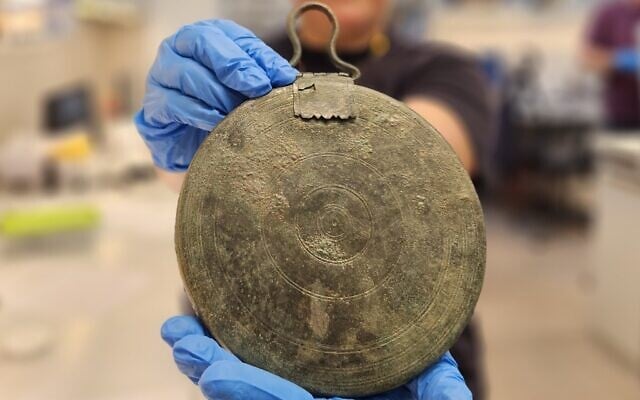A rare well-preserved bronze mirror has been found recently along with the remains of a young lady believed to be a young Greek courtesan in Jerusalem, the Israel Antiquities Authority (IAA) announced.
The findings were discovered at a cave of a tomb dating from the 4th or 3rd century BC.
The small hand “box mirror,” one of 63 of its type known to have survived, is what led researchers to the conclusion that the remains were probably that of a hetaira, as courtesans were known in Greek, the Times of Israel reports.
Greek courtesan’s mirror found in grave considered a “luxury item”
“The quality of the production of the mirror is so high that it was preserved in excellent condition, and it looked as if it was made yesterday,” said Liat Oz, the director of the IAA excavation.
“Bronze mirrors like the one that was found were considered an expensive luxury item, and they could come into the possession of Greek women in two ways; as part of their dowry ahead of a wedding, or as a gift given by men to their hetairai,” the researchers noted.

In ancient Greece, there were two versions of prostitutes, namely hetairai, or high-class escorts and courtesans, and “pornai,” or lower-class prostitutes and slaves who most often worked in brothels and on street corners.
Both men and women worked as prostitutes in ancient Greece.
The role of courtesans in ancient Greece
The hetairai formed part of an Ancient Greek social institution and were not simply escorts. They were seen as educated, interesting, and intelligent so that they could have engaging discussions with their clients.
A number of particularly alluring and intelligent hetairai became famous and garnered significant influence in ancient Greece, most notably Phryne.
Hetairai attended symposia to provide not just sex but also to perform music and even engage in debates and discussions with the participants. Ancient vases also depict sexual activity between men at symposia.
Some of them became common-law spouses of the Greco-Hellenistic rulers as well as of high-ranking generals and famous intellectuals.
The hetairai held literary salons and served as muses for the most famous works of sculpture and painting, which were even displayed in temples.
The courtesan’s remains — charred human bones — were identified as those of a woman and, according to Dr. Guy Stiebel of the Department of Archeology and the Ancient Near East at Tel Aviv University, are the “earliest evidence in Israel of cremation in the Hellenistic period.”
The Times of Israel says that according to archaeologists the most likely explanation is that the tomb belonged to a hetaira who traveled with a senior official during Alexander the Great’s conquests or the wars that followed.
Related: Sex Work in Ancient Greece: Hetairai and Flute Girls



